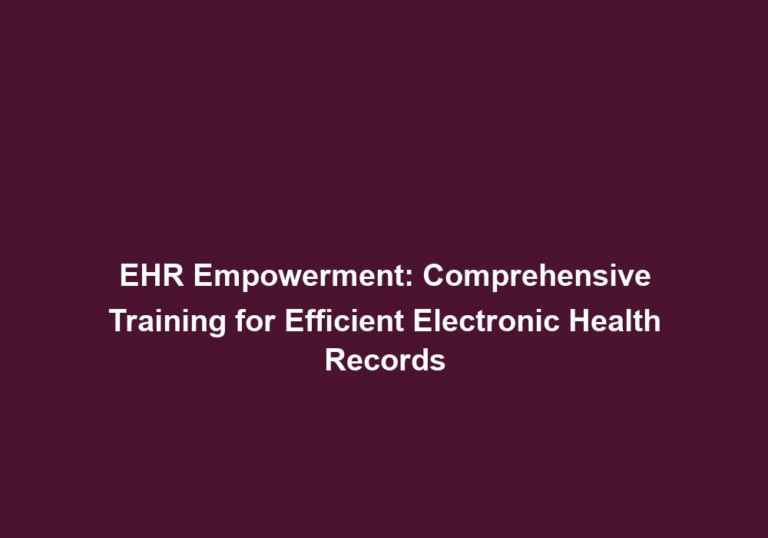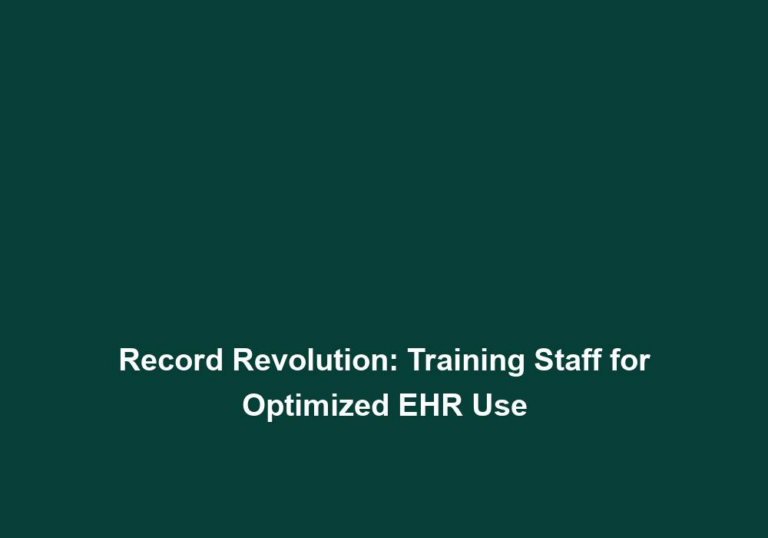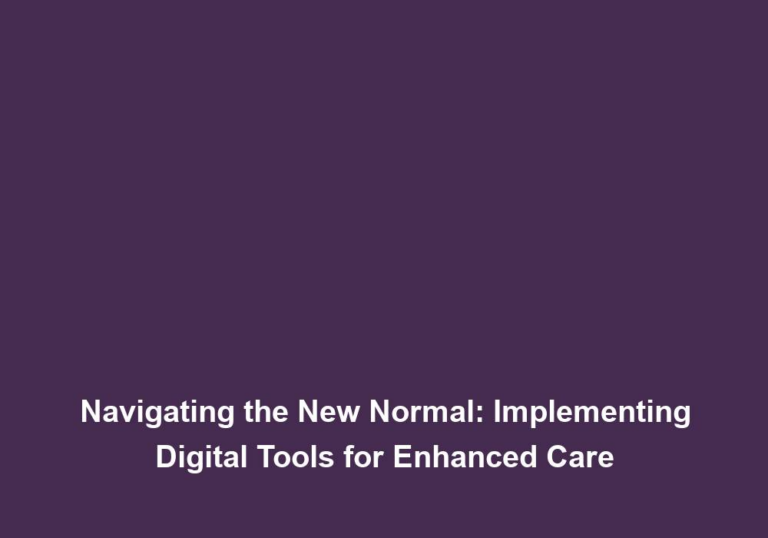Digital Care Delivered: Telehealth Solutions for the Modern Practice
In today’s fast-paced world, the digital revolution has transformed numerous industries, including healthcare. The advent of telehealth solutions has revolutionized the way medical care is delivered, providing convenient and efficient healthcare services to patients. With the ever-increasing popularity of telehealth, it is crucial for modern practices to embrace this technology to provide top-notch care and stay ahead of the curve. In this article, we will explore the many benefits of telehealth solutions and how they can enhance the effectiveness and efficiency of your practice.
The Rise of Telehealth
Telehealth, also known as telemedicine, refers to the use of digital communication technologies to deliver healthcare services remotely. With the advancement of high-speed internet, smartphones, and video conferencing tools, patients can now receive medical consultations, diagnoses, and even treatment from the comfort of their homes. This innovative approach to healthcare has gained immense popularity in recent years due to its numerous advantages.
Convenience and Accessibility
One of the primary reasons why telehealth has gained significant traction is its convenience and accessibility. Patients no longer have to wait for hours in crowded waiting rooms or travel long distances to see a healthcare professional. With telehealth solutions, patients can schedule appointments at their convenience, avoiding the hassle of commuting and waiting times.
- Patients can access healthcare services from the comfort of their homes, eliminating the need for transportation and reducing travel-related expenses.
- Individuals with limited mobility or residing in remote areas can easily connect with healthcare providers without the challenge of physical accessibility.
- Busy individuals can save time by avoiding the need to take time off work for in-person visits.
Cost-Effectiveness
Telehealth solutions are also known for their cost-effectiveness, both for patients and healthcare providers. By eliminating the need for in-person visits, telehealth reduces overhead costs associated with maintaining physical facilities.
- Patients can save on transportation expenses, including fuel costs and parking fees, which can be especially significant for those living in urban areas.
- Time off work can be minimized or even eliminated, resulting in potential savings for both patients and employers.
- Childcare costs can be reduced as patients can attend virtual appointments from home, eliminating the need for babysitters or daycare services.
This affordability makes healthcare services more accessible to a wider range of individuals, ultimately leading to better health outcomes for the population as a whole.
Enhanced Communication and Collaboration
Telehealth solutions provide healthcare professionals with an efficient means of communication and collaboration. Through secure video conferencing platforms, doctors can consult with specialists, share medical records, and discuss treatment plans, all in real-time.
- Specialists can be easily consulted regardless of geographical location, allowing for quick access to expert opinions and improving patient care.
- Telehealth enables multidisciplinary teams to collaborate seamlessly, fostering a comprehensive and holistic approach to patient management.
- Patients can communicate with healthcare providers more easily through messaging features or virtual visits, increasing engagement and satisfaction.
By facilitating enhanced communication and collaboration, telehealth solutions contribute to improved patient outcomes and a more patient-centered approach to care.
Implementing Telehealth Solutions in Your Practice
Now that we understand the benefits of telehealth solutions, let’s delve into the practical steps you can take to implement this technology in your practice.
Selecting a Telehealth Platform
The first step in implementing telehealth solutions is choosing the right telehealth platform for your practice. Consider factors such as ease of use, security features, integration capabilities with your existing electronic health record (EHR) system, and the ability to support various types of consultations (video, voice, or chat).
- Look for a platform that offers a user-friendly interface, ensuring that both healthcare professionals and patients can easily navigate the system.
- Security features, such as end-to-end encryption and secure data storage, are essential to protect patient information and comply with privacy regulations.
- Integration with your EHR system allows for seamless exchange of patient data, ensuring continuity of care and accurate record keeping.
- The ability to support different types of consultations provides flexibility and caters to the diverse needs of patients.
It is essential to select a platform that meets the specific needs of your practice and ensures the privacy and security of patient data.
Training and Onboarding
Once you have selected a telehealth platform, it is crucial to provide training and support to your staff. Ensure that all healthcare professionals are familiar with the telehealth tools and protocols to deliver high-quality care remotely.
- Conduct comprehensive training sessions to familiarize your staff with the telehealth platform, including features such as scheduling appointments, conducting virtual visits, and securely accessing patient information.
- Provide resources, such as user manuals or video tutorials, that can serve as references for staff members during the onboarding process.
- Offer ongoing support to address any concerns or challenges that may arise during the transition to telehealth, such as technical difficulties or patient communication issues.
By investing in training and support, you can ensure that your staff is equipped with the necessary skills and confidence to provide excellent telehealth services.
Streamlining Workflows
To optimize the efficiency of your telehealth practice, it is important to streamline your workflows. Integrate telehealth into your existing practice management systems, EHRs, and billing systems to minimize disruptions and enhance the overall patient experience.
- Establish clear protocols for scheduling appointments, conducting virtual visits, and handling documentation to ensure consistency and efficiency.
- Integrate telehealth into your practice management system, allowing for seamless appointment scheduling and automated reminders for both healthcare professionals and patients.
- Ensure that your EHR system is compatible with your chosen telehealth platform, enabling easy access to patient records and facilitating accurate documentation.
- Coordinate with your billing system to streamline the billing and reimbursement process for telehealth services, ensuring a smooth financial workflow.
By streamlining your workflows, you can maximize the benefits of telehealth solutions and provide a seamless experience for both patients and healthcare providers.
Ensuring Regulatory Compliance and Security
When implementing telehealth solutions, it is crucial to prioritize patient privacy and comply with relevant regulatory requirements. Ensure that your chosen telehealth platform adheres to industry standards for data security, encryption, and compliance with the Health Insurance Portability and Accountability Act (HIPAA).
- Conduct thorough research on the security features of the telehealth platform, ensuring that it meets all necessary privacy and security requirements.
- Educate your staff about patient privacy and security guidelines, emphasizing the importance of maintaining confidentiality and safeguarding patient information.
- Establish protocols and procedures for data breach prevention and response, ensuring that your practice is prepared to handle any potential security incidents.
By prioritizing regulatory compliance and security, you can maintain the trust and confidence of your patients while leveraging the benefits of telehealth.
The Future of Telehealth
With the rapid advancements in technology and the growing acceptance of telehealth by patients and healthcare professionals alike, the future of telehealth appears promising. As artificial intelligence, virtual reality, and remote monitoring technologies continue to evolve, telehealth will become even more sophisticated and integrated into routine healthcare practices.
- Artificial intelligence (AI) can enhance telehealth by enabling automated diagnosis and treatment recommendations based on patient data analysis.
- Virtual reality (VR) technology can create immersive healthcare experiences, allowing patients to virtually visit healthcare providers or participate in therapy sessions from the comfort of their homes.
- Remote monitoring technologies, such as wearable devices or sensors, can provide real-time health data to healthcare professionals, enabling proactive and personalized care.
Telehealth has the potential to transform the healthcare landscape, enabling personalized and accessible care for individuals across the globe. By embracing telehealth solutions, modern practices can revolutionize the way they deliver care, enhance patient outcomes, and stay at the forefront of the ever-changing healthcare industry.
In conclusion, telehealth solutions offer numerous benefits for modern practices. From increased convenience and accessibility to cost-effectiveness and enhanced communication, implementing telehealth can significantly improve the effectiveness and efficiency of your practice. By selecting the right telehealth platform, providing adequate training and support, streamlining workflows, and ensuring regulatory compliance, your practice can leverage the power of telehealth to deliver top-notch care in the digital age. Embrace the digital revolution and unlock the full potential of telehealth for your practice and your patients.







